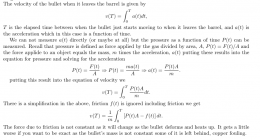So that isolates gas expansion and pressure as being directionally net neutral. There are only two components at play, gas and the bullet.
The other part of this is a moving solid. So, does the weight of part of the “system” traversing the system end to end cause dislocation?
If under the power of that part of the system I’d say yes. I cannot walk across a platform on ball bearings without pushing against it. To traverse it, I will invariably move the platform the opposite direction, somewhat.
If the platform had electromagnets affixed that propelled a levitating mass, then yes, again. But a rifle doesn’t propel the bullet, and neither does the bullet propel itself. Rather, this would be like inserting a zerk fitting between the bullet and the bolt and slowly introducing oil pressure. Do they both move? I don’t know, but as the force isn’t being applied by either the gun or the bullet, I don’t think it necessarily* invokes the equal and opposite action, principle.
Tons and tons of water careening down a water slide under the influence of gravity do not “push” the physical structure in the opposite direction of the water’s motion. A 000 buck ball in a barrel that is tilted down and starts rolling toward the end does not push the barrel backward whatsoever, so there is nothing inherent about rearward motion in a bullet moving forward.
A bowling ball rolled down a lane is not under its own power, it’s exerting force down, and slightly forward in the direction it’s going as the lane slows it down. Certainly no equal and opposite force, which is often applied generally here.
Combine the two concepts, - a drag racing car attempts to curl the asphalt under and behind the rear tires, to the rear. If I extend a winch’s hook to the car and pull it with a cable, the car exerts no lateral pressure on the asphalt. ** if we pull a bullet out of the barrel from the front, the gun isn’t going to try to move backward, I don’t believe, under the equal and opposite principle.
Obviously the bullet is not self powered. The gas, as explained, seeks out lower pressure with the net effect of neutrality in moving the object containing it in any particular direction. The bullet is simply acting as an enlargement of the expansion chamber.
At all relevant times to the question, pressure is contained by the gun, so where am i missing something here? Where does the net rearward force come from when there is no “vent” until the back of the bullet passes the muzzle?












